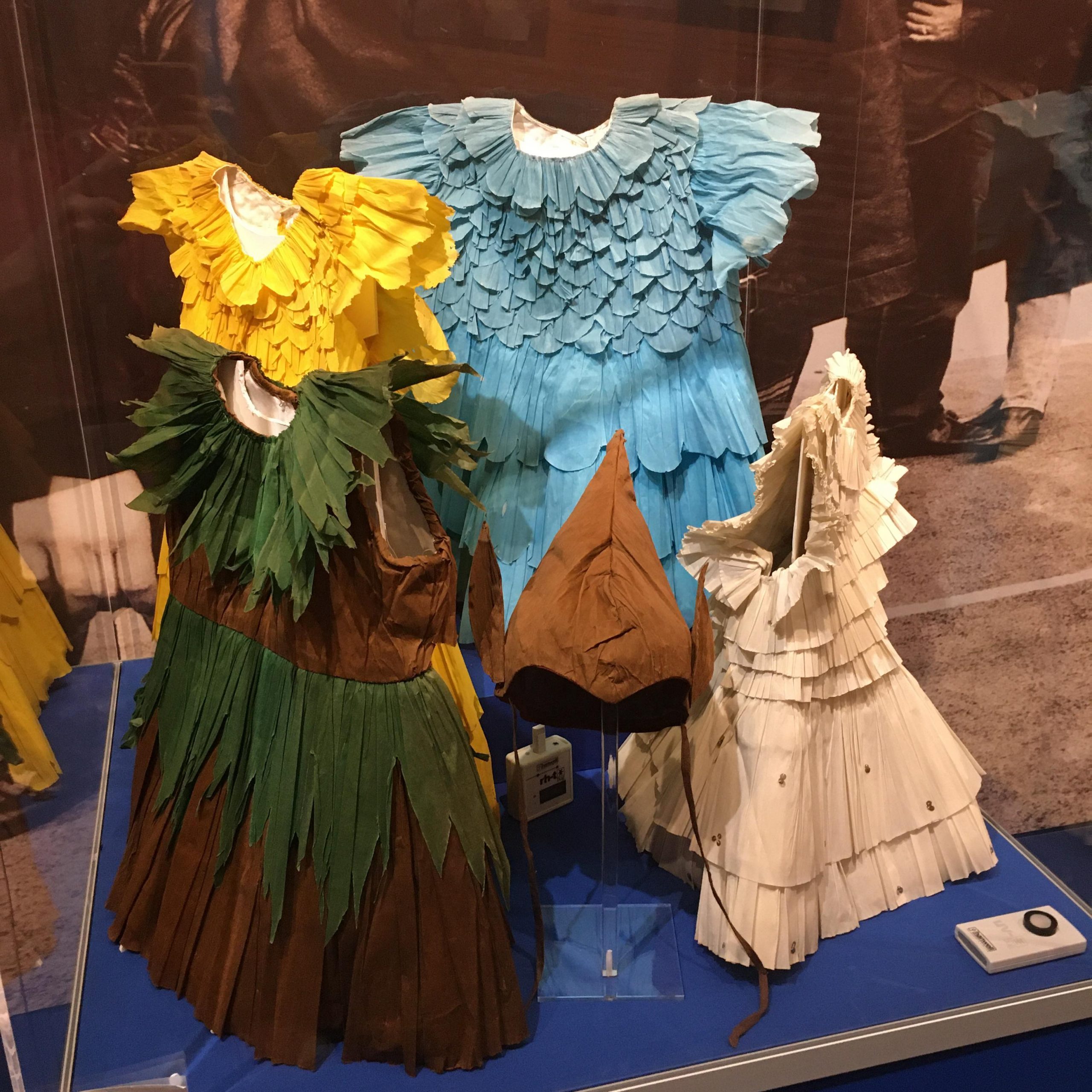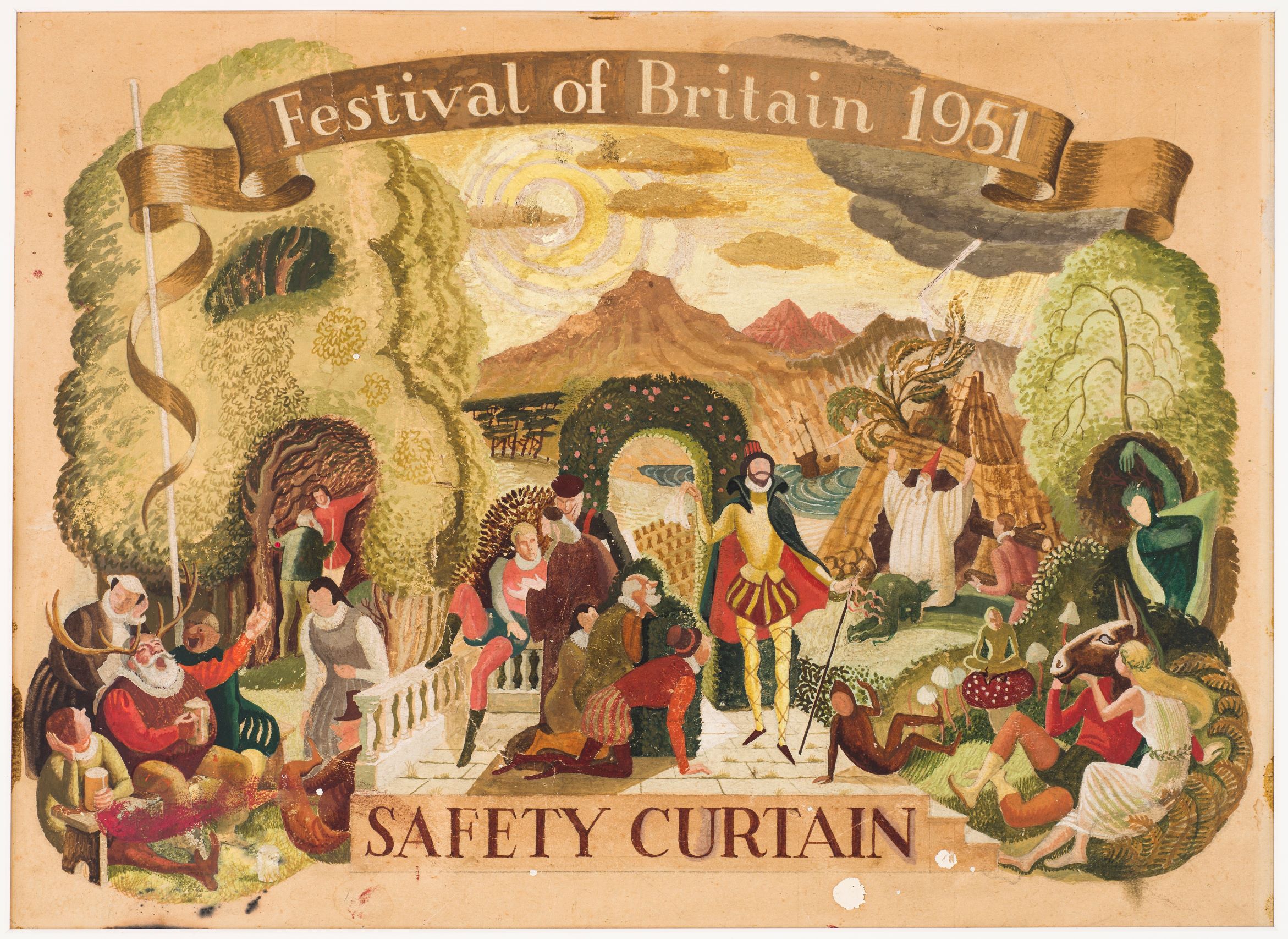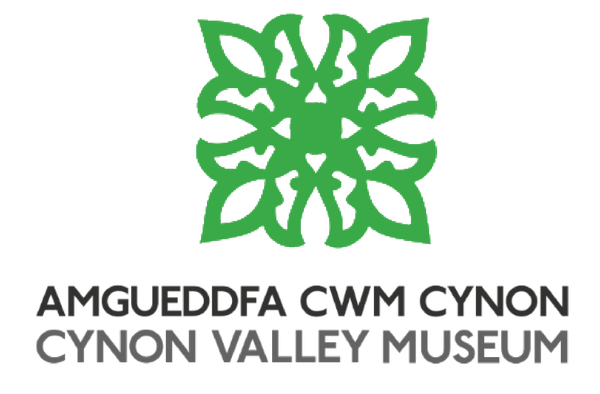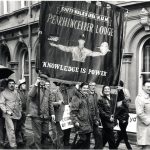This blog post tells the story of local celebrations linked to the National Festival of Britain 1951 through objects in our collection, such as a theatre safety curtain and paper dresses.
In 1951, six years after World War Two, Britain was still recovering from the social and economical effects of wartime. The Festival of Britain was created with the aim of promoting a feeling of recovery for the nation and to inspire a shift into a better Britain. The festival would celebrate British industry, arts and science by showcasing principles of urban design through a post-war rebuilding of London.

The Festival of Britain emblem, designed by Abram Games, from the cover of the South Bank Exhibition Guide, 1951. Image from Wikimedia (user Pelarmian).
This festival was considered a commemoration of The Great Exhibition 1851, a world fair that celebrated the art of industry and the developments of the Industrial Revolution.
The festival was funded by The Arts Council, which also received an additional £400,00 from the Treasury. The annual report of the Arts Council of Great Britain 1951-1952 boasted that the five-month celebration allowed a very good trading season in 1951.
The main site was based in South Bank, London, which was at the time a 27-acre area left untouched after the bombings of the war.
The area was used to showcase modern principles of urban design and incorporated the rebuilding of post-war London and other towns and cities.
Welsh involvement
Whilst the festival was considered a national affair focusing on the four nations, some perceived it as being fairly London-centric. However, events and activities did occur throughout Wales and Scotland.
At this point, the Welsh Committee for the Arts Council was not autonomous and therefore had no money of their own to allocate and spend. The Welsh Festival Committee had decided that the annual celebrations of Welsh culture in Llangollen (the Eisteddfod) would be Wales’ contribution to the Festival. Even so, more events in Wales were recorded, such as the Pageant of Wales and the St. Fagan’s Folk Festival, both held in Cardiff.
Interestingly, as part of the Festival celebrations, St. Fagans held a National Exhibition of Quilting. Many prizes were awarded, including Irene Morgan, originally from Aberdare, who was known as one of the best quilters of her generation. Her prize-winning certificates were donated to St Fagan’s and can be found on their online Collections Archive (link).
However, Welsh Councils were also provided with grants in order to cover certain costs for the plans for the Festival. For example, the annual report for the Council of Social Service for Wales & Monmouthshire states that they received a grant of £515.90 for the Festival of Britain. This covered costs such as salary and state insurance, rent, lighting, heating and cleaning, telephones, telegrams, and postages.
Celebrations in the Cynon Valley
More importantly, objects from the Cynon Valley Museum collection highlight that events and activities took place on a local level and created a sense of morale amongst the post-war communities in the area.
Letter correspondence between Hirwaun Welfare Association and the local council / surrounding art groups highlight their plans for the festival, organising a Festival Week during 29th April – 5th May 1951. Descriptions of the festival include ‘indoor entertainment’ comprising of ‘shows that will meet all tastes of the community i.e. drama, choral singing, variety, Nos Lawen or Sut Hwyl.’ Similarly, there are descriptions of ‘outdoor entertainment’ including, ‘soccer matches, rugger matches, children’s sports with bowls and tennis tournaments.’
The Hirwaun Welfare Association sent many letters to art groups in surrounding areas such as Maerdy (Rhondda) Morriston (Swansea) and Resolven Dramatic Society, expressing how their involvement would assist in making ‘a happy and memorable week for Hirwaun.’ Similarly, the Association contacted people with connections to the B.B.C. and the Rugby League.

ACVMS 1991.184_006

ACVMS 1991.184_011

ACVMS 1991.184_009

ACVMS 1991.184_001 Letter communications from the Hirwaun Welfare Association about their plans for the Festival of Britain 1951.
In Aberdare, a large school concert was held at Coliseum Theatre. The schools were split into groups depending on areas (upper, lower, and town) and presented their concerts on different dates throughout June 1951.

ACVMS 2012 142 “Festival of Britain 1951 Aberdare School Concerts”

Interestingly, the museum collection also contains a small collection of paper dresses; it is possible that these dresses were worn by children for one of the shows described in the program. For example, a show on Thursday 21st June 1951 featured dancing in a segment called ‘The Fairy Glen’ with the Aberaman Infants as the performers.

Crepe paper dresses with fabric lining. Worn during Festival of Britain 1951 celebrations. Photograph by CVM.
Similarly, the Rhondda Music Week was held between 4th – 9th June to celebrate the Festival of Britain. This included a large marquee erected at the old Pentre Colliery estate.

Image 3133 reproduced by kind permission from Rhondda Cynon Taf Libraries. A marquee was erected on the old Pentre Colliery site for Rhondda Music Week, 4th – 9th June 1951.
The Coliseum Theatre Fire Curtain
In 1950 the Glamorgan County Fire Service insisted on the installation of a safety curtain in the theatre to meet statutory requirements. The Management Committee was unable to meet the cost of installing a curtain and there was a possibility that the Coliseum would have to close as a theatre and adapt the building for cinema use, which was exempt from the regulations.
However, the Arts Council came up with a sum of £1,500, together with grants from the Council of Social Services, the Aberdare Urban District Council and Aberdare Cables which enabled the management to comply with the regulations and fit a curtain.

The Seventh Annual Report of the Arts Council of Great Britain, 1951-52, page 54.
It was inaugurated in August 1951 during a concert given by Welsh National Opera when the curtain was lowered by Myra Owen, acting Director of the Welsh Committee of the Arts Council. When installed the curtain was painted grey and it was decided that as 1951 was the year of the Festival of Britain some commemorative design be added to it. The Management Committee suggested a competition to encourage entries and offered a prize of £25 for the best design. There were eighteen entries and the competition was won by Scott Nisbet (1910-2002) an art lecturer at University College, Aberystwyth. The winning design is reproduced on the print. The committee was so pleased with it they doubled the prize money.

ACVMS 1992 129_001 Painted design for the theatre fire curtain by Scott Nisbet.
As can be seen from the print the design depicts all Shakespeare’s comedy characters in costume; they are set in a landscape and the curtain carries the words Festival of Britain, 1951. In order to execute the design the print was projected onto the large proscenium safety curtain and the figures etc. were then sketched in and hand-painted.
The curtain was shown to the public for the first time during a performance by the famous Welsh actor, playwright, and author, Emlyn Williams. He was appearing at the Coliseum in his one-man show of readings from the works of Charles Dickens. Williams had the honour of lowering the curtain and revealing the artwork.
Unfortunately, the painting has been obliterated from the curtain, possibly because it was painted onto asbestos and subsequent Health and Safety Regulations required the removal of this material. The print in the museum is therefore the only tangible evidence of this interesting piece of the Coliseum’s history.
Written by Rhian Hall and Geoffrey Evans, May 2021.
Sources:
The Arts Council of Great Britain, (1952) The Seventh Annual Report1951 – 1952, Available online at: https://www.artscouncil.org.uk/sites/default/files/download-file/The%20Seventh%20Annual%20Report%20of%20the%20Arts%20Council%20of%20Great%20Britain%201951-1952.pdf
The Council of Social Service for Wales & Monmouthshire Incorporated, (1952), Fourth Annual Report 1950 – 1951. Available online at: https://wiserd.ac.uk/sites/default/files/documents/wcva_annualreport_1950-1951.pdf
Davies, D R., ‘The History of the Coliseum’, lecture given for The Cynon Valley History Society.
Johnson, B. (2016). The Festival of Britain 1951. Historic UK. [Accessed April 14th 2021] Available from: https://www.historic-uk.com/HistoryUK/HistoryofBritain/The-Festival-of-Britain-1951/
Johnson, B. The Great Exhibition 1851. Historic UK. [Accessed April 23rd 2020] Available from: https://www.historic-uk.com/HistoryUK/HistoryofEngland/Great-Exhibition-of-1851/
Jones, M., (2019). The Festival of Britain (1951) beyond London. Mémoire(s), identité(s), marginalité(s) dans le monde occidental contemporain. 20. 1-22. DOI: https://doi.org/10.4000/mimmoc.3625
Phillips, E. (2016). Festival of Britain 1951 – the National Exhibition of Quilting. National Museum Wales Amgueddfa Blog. [Viewed April 20th 2021] Available from: https://museum.wales/blog/2016-08-25/Festival-of-Britain-1951–the-National-Exhibition-of-Quilting/
Rhondda Cynon Taf Library Service Digital Archive. Available from: https://archive.rctcbc.gov.uk/home?WINID=1621424328643
Further reading:
Cox, I. The South Bank Exhibition, A Guide to the Story It Tells, London 1951, H.M. Stationery Office, 1951, p.6.




